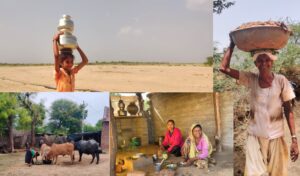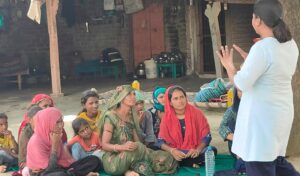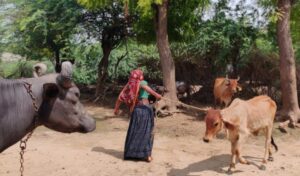Variability and volatility have become the new normal of our climate system. As global attention turns towards climate extremes, researchers with the ANTICIPATE project are examining how local communities experience the ‘extreme’ variability as droughts and floods coincide. Using visual co-production techniques, they unpack the multi-dimensional experiences of variability in the field site in rural Gujarat, capturing the hidden, latent, and visible aspects of change.

Since March 2022, we have been using visual co-production techniques as part of the ANTICIPATE project to engage with the farmers, farm labourers and livestock owners to co-produce knowledge. By collaborating with community members, we initiated a reflective and socially critical dialogue to understand their lived experiences of weather variability and its co-location along with other socio-economic drivers of vulnerability (such as migration and land use change). Embracing these co-produced visual methods by the community provided us an intimate understanding of how local communities contend with different forms of variability, ranging from weather to changing resource and market regimes. We observed how these intersections often compound impacts but at the same time provide sources of preparedness.
Techniques of visual co-production: adapting to context
Through engaged documentary photography, (a form of photography where the research team has critically engaged with all social intersections including gender, caste, class, age and religion in the village) we are developing an extended photo stories that reflect the daily lives of the local communities. This covers the spectrum of weather variability, including heatwaves, droughts, erratic patterns of rainfall experienced during the monsoon and more recently, in the winter and spring season.
A snapshot of everyday practices in the village:

Drawing on the images taken by the researchers over the last one and a half years, we decided to start with the photo-elicitation process as it takes less time than embedding the photovoice approach where participants must be trained to use cameras and record narratives. This approach especially helped us with the women participants overburdened with routine chores, which increase with unexpected weather variability. We showed them pictures of the unending stream of their daily activities, which remains unpaid and hidden. These became great entry points to start a conversation and evoked various responses.

The ‘hidden’ costs of response and preparedness: unpacking latent issues
The photos evoked deep emotions, memories, and ideas. A significant portion of the women’s perception and their memories of the landscape pertained to water access, a sense of place and identity. For example, during this process, activities and narratives surfaced about the everyday caregiving activities of women which included working on the farms, storing of grains, taking care of the livestock, carrying milk to the local dairy; along with a host of the usual activities that make up their daily bundle of chores.
This work escalated during unexpected events such as rains during the sowing or harvesting season. Though mentioned in the interviews, the photo-elicitation process helped evince different emotional responses like talking about the loss of crops, migration experiences, and having to enroll the children as agricultural labour in a different village.

Recognising change: differentiated and intersectional experiences through time and space
The engagement facilitated a verbal participatory conversation. The lack of uniformity in their reflections with gender, age and caste, even within a given context, mirrored the difference in contextual experiences of an individual from the groups depending on the vantage points of their daily lived experience. Photo-elicitation provided an understanding of the impact of evolution over time on their livelihood, food security, shelter, displacement and change of identity in terms of their personal and community experiences. For example, the Bharwad households, which possess a significant number of livestock, use dry cattle dung as a source of fuel for cooking. In contrast, other communities venture outside to gather dry wood to use as fuel for cooking. This is a task predominantly undertaken by young girls and women in the village.
During a photo-elicitation exercise, a young girl stated:
“My mother and other women in the village engage in the traditional practice of preparing the floor before the monsoon. They used to mix sand and dung, apply it on the floor with their hands and then with their feet they sharpen the surface and let it dry to create a rigid surface that could protect against soil erosion caused by rainwater and prevent insects from coming through the ground. However, this process demanded time, physical effort, and precision. Nowadays, girls my age use a basic technique called “lipan”, which involves using only sand to create a smoother surface. Additionally, we prefer to build our floors with ceramic tiles to avoid having to follow the tedious traditional process every monsoon.”
Local agricultural market and storage facilities:

In discussions on the photos, they revealed their engagements in dealing with uncertainty, the changing landscape and its cascading risks – especially their relationship with the mandi (wholesale market for agricultural produce). The vulnerable households who are often unable to afford concrete storage either lose a part of their crops during unseasonal rainfalls or the partially damaged crop fetches much less than the usual rate in the mandis.
Reversing the gaze and shedding the hubris as a researcher
Observations from an adolescent girl, who is pursuing higher secondary education in the village:
“Photos used during the exercise serve as an entry point for initiating conversations about the community’s experiences, challenges, importance, and needs, particularly in the face of climate uncertainty. For me and my community, this is critical to sustaining our livelihoods and preparing for the future.”
Our journey started with unpacking extremes – we used both floods and drought as our entry points of conversation. However, we soon realised that even these terms were too homogenous and abstract for the local communities. In many ways, the photo-elicitation process challenged the researcher’s gaze and nudged us to rethink our vocabularies of inquiry and exploration. This process made us recognise the importance of the everyday life of extremes, and what happens between them is as essential to unpack as the episode itself. We continue to unpack the social constructions of extremes to think about preparedness from the ground up in our ongoing fieldwork as we now start to engage with design-based methods in or next phase of work.
